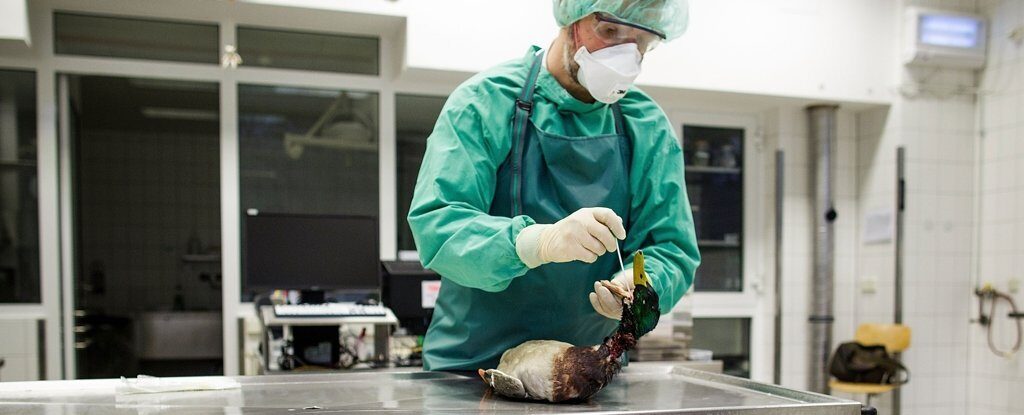H5N8, a subtype of highly pathogenic avian influenza virus (HPAIV), was identified decades ago, but during 2020 a series of emerging and ongoing H5N8 outbreaks in avian populations across dozens of countries have led to the death or slaughter of millions of birds worldwide.
"The affected geographic regions have been expanding continuously, and at least 46 countries have reported highly pathogenic H5N8 AIV outbreaks," virus researchers Weifeng Shi and George F. Gao write in a new perspective article in Science, warning of the dangers of H5N8 if we don't closely monitor and contain this worrisome trend.
While the most vulnerable animals to H5N8 are different kinds of birds (including farmed chicken and ducks, but also wild and migratory birds), human cases of the virus have also been discovered in recent times.
An outbreak of the avian flu in Russia in December 2020 jumped to poultry workers, with seven people on a farm in southern Russia showing signs of the infection - representing the first time H5N8 had ever been found in humans.
While that was a first for H5N8, it certainly wasn't a first for clades and subclades related to H5N8, nor for avian flu viruses in general.
"To date, there have been a total of 862 laboratory-confirmed human cases of infection with H5N1 reported to the World Health Organization (WHO), including 455 deaths," Shi and Gao explain. "These cases were from 17 countries, with ~76 percent from Egypt and Indonesia."
But zoonotic risks are only part of the problem with H5N8 and its ilk. In most of the recent outbreaks, a clade of H5N8 called 2.3.4 has become the dominant pathogen worldwide, first seen in a Chinese wet market in 2010.
"Clade 2.3.4 H5 AIVs, particularly the H5N8 subtype, have clearly displayed a propensity for rapid global spread in migratory birds," the researchers write, noting that these viruses also display evidence of constant evolution, genetically reassorting themselves with parts of other AIV subtypes.
Shi and Gao - respectively from China's Shandong First Medical University and the Chinese Center for Disease Control and Prevention - were among some of the first scientists to document the novel coronavirus in early 2020.
They note that the subsequent COVID-19 pandemic - and the prevention and control measures world populations enacted in response - saw a sharp reduction in the spread of seasonal human influenza A and B viruses in the last year.
Comment: Herd immunity to the coronavirus occurred much slower because of the lockdowns, and scientists are predicting that lockdowns have also prevented circulation of seasonal flu strains, meaning that this years could be much more severe than usual. The situation is even worse when we consider the battering people's immune systems have suffered due to the relentless fearmongering, lack of human contact and the stress this causes; the lack of sunlight and exercise; the enforced mask wearing and the significantly detrimental impact it has on health; and, probably worst of all, this is on top of the experimental vaccine programs that have been dogged by reports of serious side effects: Connecticut reports at least 18 cases of heart problems in young people after Covid-19 vaccine, CDC issues alert to doctors
Nonetheless, in the same timeframe, a number of highly pathogenic H5Ny AIVs, including H5N1, H5N2, H5N5, and H5N8 subtypes, spread across China, South Africa, Europe, Eurasia, and elsewhere.
At the same time, research has shown that clade 2.3.4 viruses show particular cell-binding adaptations that could pose greater risks for human transmission, including potentially human-to-human transmissibility.
In all, the researchers say we need to significantly step up our surveillance of HPAIVs in poultry farms now, before these pathogens fly the coop.
"Because of the long-distance migration of wild birds, the innate capacity for reassortment of AIVs, the increased human-type receptor binding capability, and the constant antigenic variation of HPAIVs, it is imperative that the global spread and potential risk of H5N8 AIVs to poultry farming, avian wildlife, and global public health are not ignored," Shi and Gao write.
The findings are reported in Science.




Nothing to do with the food reset where we all eat bugs and drink sewage to appease freaks called Greta and Klaus.
I noticed chicken and duck were on the infection list. So no fried chicken for BLM, and no Peking duck for the Chinese.
Ohhhhh.... This must be the systemic racism I hear so much about. 😏😜🤣